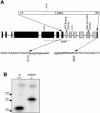Reduction of stability of arabidopsis genomic and transgenic DNA-repeat sequences (microsatellites) by inactivation of AtMSH2 mismatch-repair function
- PMID: 12970498
- PMCID: PMC196609
- DOI: 10.1104/pp.103.023952
Reduction of stability of arabidopsis genomic and transgenic DNA-repeat sequences (microsatellites) by inactivation of AtMSH2 mismatch-repair function
Abstract
Highly conserved mismatch repair (MMR) systems promote genomic stability by correcting DNA replication errors, antagonizing homeologous recombination, and responding to various DNA lesions. Arabidopsis and other plants encode a suite of MMR protein orthologs, including MSH2, the constant component of various specialized eukaryotic mismatch recognition heterodimers. To study MMR roles in plant genomic stability, we used Arabidopsis AtMSH2::TDNA mutant SALK_002708 and AtMSH2 RNA-interference (RNAi) lines. AtMSH2::TDNA and RNAi lines show normal growth, development, and fertility. To analyze AtMSH2 effects on germ line DNA fidelity, we measured insertion-deletion mutation of dinucleotide-repeat sequences (microsatellite instability) at nine loci in 16 or more progeny of two to four different wild-type or AtMSH2-deficient plants. Scoring 992 total alleles revealed 23 (2.3%) unique and 51 (5.1%) total repeat length shifts ([+2], [-2], [+4], or [-4] bp). For the six longest repeat loci, the corresponding frequencies were 22/608 and 50/608. Two of four AtMSH2-RNAi plants showed similar microsatellite instability. In wild-type progeny, only one unique repeat length allele was found in 576 alleles tested. This endogenous microsatellite instability, shown for the first time in MMR-defective plants, is similar to that seen in MMR-defective yeast and mice, indicating that plants also use MMR to promote germ line fidelity. We used a frameshifted reporter transgene, (G)(7)GUS, to measure insertion-deletion reversion as blue-staining beta-glucuronidase-positive leaf spots. Reversion rates increased only 5-fold in AtMSH2::TDNA plants, considerably less than increases in MSH2-deficient yeast or mammalian cells for similar mononucleotide repeats. Thus, MMR-dependent error correction may be less stringent in differentiated leaf cells than in plant equivalents of germ line tissue.
Figures



Similar articles
-
Involvement of the Arabidopsis thaliana AtPMS1 gene in somatic repeat instability.Plant Mol Biol. 2004 Oct;56(3):339-49. doi: 10.1007/s11103-004-3472-0. Plant Mol Biol. 2004. PMID: 15604748
-
Rapid accumulation of mutations during seed-to-seed propagation of mismatch-repair-defective Arabidopsis.Genes Dev. 2004 Nov 1;18(21):2676-85. doi: 10.1101/gad.1217204. Genes Dev. 2004. PMID: 15520284 Free PMC article.
-
Impact of the loss of AtMSH2 on double-strand break-induced recombination between highly diverged homeologous sequences in Arabidopsis thaliana germinal tissues.Plant Mol Biol. 2007 Apr;63(6):833-46. doi: 10.1007/s11103-006-9128-5. Epub 2007 Feb 9. Plant Mol Biol. 2007. PMID: 17294256
-
Deficient DNA mismatch repair: a common etiologic factor for colon cancer.Hum Mol Genet. 2001 Apr;10(7):735-40. doi: 10.1093/hmg/10.7.735. Hum Mol Genet. 2001. PMID: 11257106 Review.
-
Disease-associated repeat instability and mismatch repair.DNA Repair (Amst). 2016 Feb;38:117-126. doi: 10.1016/j.dnarep.2015.11.008. Epub 2015 Dec 12. DNA Repair (Amst). 2016. PMID: 26774442 Review.
Cited by
-
Dissimilar mispair-recognition spectra of Arabidopsis DNA-mismatch-repair proteins MSH2*MSH6 (MutSalpha) and MSH2*MSH7 (MutSgamma).Nucleic Acids Res. 2003 Oct 15;31(20):6027-34. doi: 10.1093/nar/gkg780. Nucleic Acids Res. 2003. PMID: 14530450 Free PMC article.
-
Involvement of the Arabidopsis thaliana AtPMS1 gene in somatic repeat instability.Plant Mol Biol. 2004 Oct;56(3):339-49. doi: 10.1007/s11103-004-3472-0. Plant Mol Biol. 2004. PMID: 15604748
-
Construction of a supF-based system for detection of mutations in the chromosomal DNA of Arabidopsis.Mol Genet Genomics. 2013 Dec;288(12):707-15. doi: 10.1007/s00438-013-0783-3. Epub 2013 Oct 24. Mol Genet Genomics. 2013. PMID: 24154629
-
Rapid generation of rice mutants via the dominant negative suppression of the mismatch repair protein OsPMS1.Theor Appl Genet. 2012 Sep;125(5):975-86. doi: 10.1007/s00122-012-1888-5. Epub 2012 Jun 12. Theor Appl Genet. 2012. PMID: 22688271
-
The role of AtMSH2 in homologous recombination in Arabidopsis thaliana.EMBO Rep. 2006 Jan;7(1):100-5. doi: 10.1038/sj.embor.7400577. EMBO Rep. 2006. PMID: 16311517 Free PMC article.
References
-
- Ade J, Belzile F, Philippe H, Doutriaux M-P (1999) Four mismatch repair paralogues coexist in Arabidopsis thaliana: AtMSH2, AtMSH3, AtMSH6-1 and AtMSH6-2. Mol Gen Genet 262: 239-249 - PubMed
-
- Baker SM, Bronner CE, Zhang L, Plug AW, Robatzek M, Warren G, Elliott EA, Yu J, Ashley T, Arnheim N et al. (1995) Male mice defective in the DNA mismatch repair gene PMS2 exhibit abnormal chromosome synapsis in meiosis. Cell 82: 309-319 - PubMed
-
- Bell CJ, Ecker JR (1994) Assignment of 30 microsatellite loci to the linkage map of Arabidopsis. Genomics 19: 137-144 - PubMed
-
- Boyer JC, Yamada NA, Roques CN, Hatch SB, Riess K, Farber RA (2002) Sequence dependent instability of mononucleotide microsatellites in cultured mismatch repair proficient and deficient mammalian cells. Human Mol Genet 11: 707-713 - PubMed
Publication types
MeSH terms
Substances
Grants and funding
LinkOut - more resources
Full Text Sources
Other Literature Sources
Molecular Biology Databases

